I have been in cities caught between the ages before, but none quite like Manchester.
Anyone who’s ever been a music fan knows there’s a kind of magic courses through this city, but I wish I felt it as my feet beat the streets in 2016. From Joy Division and the Smiths to Stone Roses and Oasis, this city contributed hugely to sounds I loved in my college years.
Wandering Manchester, I’m struck by what an oddly mixed vibe it has. From disenfranchised young men through to a business district coursing with optimism for a new future, Manchester represents an England alive and well in pop culture.
The disaffected angst-riddled legacy of Thatcherism echoes in some corners of the city even now. Uninspired, ugly architecture of the ‘60s through ‘90s, that Prince Charles has spent his life railing against, is rife in parts of this town. Scattered in other parts are bricked buildings so famously associated with this region of Britain from the 1700s on.
Look around, though, and cranes dot the skies amidst a gleaming modern city being built for tomorrow. This stands in opposition to the funky Northern Quarter. There you’ll find oddball stores, vinyl shops, and thriving cafes staking a claim to the quirkiness still flowing from the “Madchester” days of raves and Happy Mondays.

Nothing quite says “Madchester” like a psycho leprechaun, eh?
Vanishing Past
Unlike most places I have been, there is no “old town” here in the city that always hustles — the birthplace of the Industrial Revolution. Against that bleak backdrop, I’m siting in the John Rylands Library as I type. Considered among the most regal and beautiful libraries on Earth, I find it odd history isn’t around every corner like you expect in much of England.
In World War II’s early days, during 1940, this city took a beating from the Germans. Those Christmas Blitzes leveled block after block of this industrial hub. A major manufacturing center, it was a key strategic bombing site for the Nazis. Just like shipbuilding centers elsewhere were.
On one night, December 22, 1940, nearly 300 tons of high-explosives and over 1,000 incendiary bombs were dropped on the city. Between December 22 to 24, nearly 700 people lost their lives here and 2,364 were wounded.
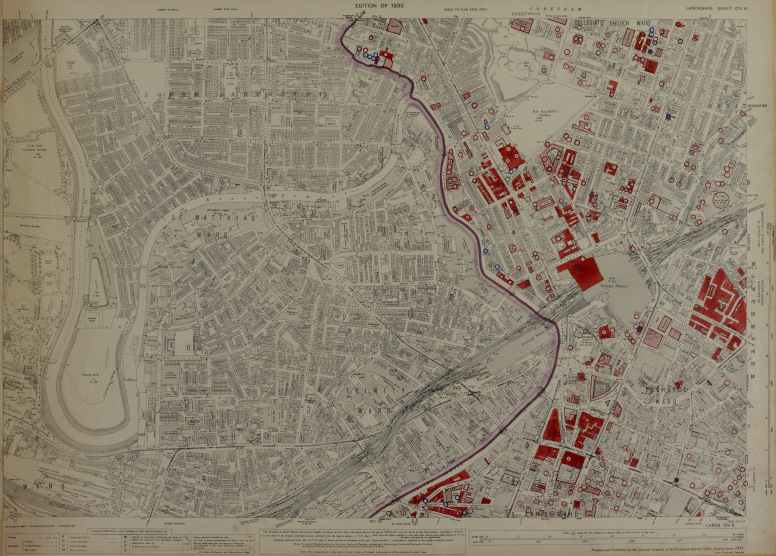
Areas destroyed by bombs on those two fateful nights are in red. Map from the University of Manchester Archives.
This impact is still felt even now. Yesterday, a tourism bloke indicated two ornate Victorian buildings sandwiching an uninspired mid-century building on Portland Street. He explained that this was because the original center building had been leveled by a bomb in the blitz.
More destruction was unleashed in Manchester thanks to the Provisional IRA. Their 1996 bombing led to several buildings being destroyed, totaling £1.2 billion in today’s currency. 212 people were injured, but they were spared fatalities. A full third of Manchester’s retail district had to be redesigned amidst destruction and chaos.
One can’t attribute all the loss of architectural history to those tragedies, though.
Ground Zero for Socialism
After all, Marx & Engels wrote The Communist Manifesto in part because of vile living conditions endured by Manchester’s working class. Friedrich Engels arrived here in 1842 at the impressionable age of 22. He worked for his father’s textile factory, taking up a working woman as a lover. That relationship showed him see the seedy side of the factory workers’ lives. He left later and wrote The Conditions of the Working Class in England for a German audience in 1845. Three years later, penned the Communist Manifesto with his buddy Marx, who would later write Das Kapital.
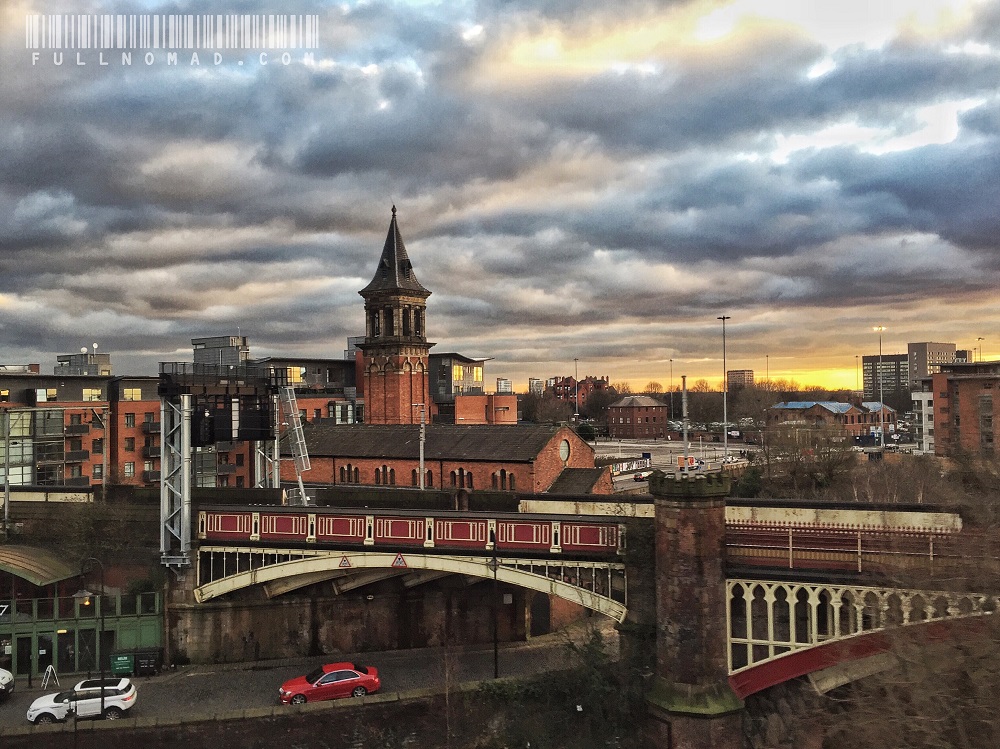
Riding out of downtown on the Metrolink, this was my first real glimpse of Manchester.
I guess “industrial Manchester” wasn’t nostalgic for locals. Like the merchant shipping industry in Leith, “industrial Manchester” likely spurred mixed feelings. This town suffered hard times, labour strife, industry losses, and more, all of which many of us will never relate. Whatever didn’t last for nostalgic reasons was probably demolished or modernized in the ever-marching stride of progress and industry.
Similarly, the docks and ships of Leith are either long gone or modernized. Today it’s left a wake of those who lament its passing because, good or bad, it defined the region for centuries.
I believe we are who we are because of the struggles and pain we endure. I feel the same about cities. When it comes to having the opportunity to walk through Phnom Penh’s Killing Fields or Germany’s Auschwitz, I’ll go. It’s part of our collective consciousness, and to burn it or demolish it as if it never existed is not a luxury many have. For them, their family legacies were forever altered as a result of those places.
I wish more of those Mancunian industrial buildings had survived, but the UK’s population crunch requires land used well for today’s populace.
A Changing Aesthetic
On the upside, in Manchester today I see a city with an idea where it’s going. It’s choosing glassy, funky modern architecture and embracing space and lines the way good design should. It’s taking bold chances, and I think it’s paying off with a sharp-looking city beginning to have great appeal.
These new structures break up eyesores and ugly, utilitarian buildings of the late-20th century that were born out necessity, limited capital, and very little creativity.
To be fair, that just isn’t a Manchester problem, it’s a problem everywhere I’ve been. It seems everyone forgot aesthetics for about 30 years. When in Edinburgh, I deliberately shot photos around the ugly late-century buildings I found jarring between buildings that preceded them by a century or two.
Manchester’s new buildings are laudable. The Mancunian powers that be seem intent to show creativity is a virtue in this town. Unique buildings that break the mold have found a home here. One that wowed me is the very edgy, asymmetrical, almost brutalist Civic Justice Centre, now called the “Filing Cabinet” by those who love and loathe it.
So one finds beauty, history, culture, and personality dotting downtown Manchester, whether it’s in the slowly-gentrifying Northern Quarter, or here, in the mighty halls of the Rylands Library, where I’m typing my missive for you.
For its past and its future, its science and music and sports, local beers, good food and good-natured people, Manchester deserves to rank higher on your list if you’re visiting the UK. It’s worth noting there is a ton of construction in Manchester right now, which will be ongoing until 2017, when they hope to finish alterations to the city’s Metrolink trams. There’ll still be a ton of other construction out there, but that’s progress for you, and it’s what you can expect from the city that put the world to work.

The Manchester Civil Justice Centre is one of those rare cool buildings I really love. Called the Filing Cabinet by many, I think it is a real testimony to the ongoing “open file” process of justice. The transparent wall on the side reminds me of why architect Arthur Erickson said he put a glass roof on the Vancouver Law Courts — because justice should be transparent.
Places to See in Manchester
I spent a week in Manchester but, as a digital nomad, I spent much of that working. The weather seemed unwilling to welcome me for most of the week and I was too tired to put up a fight. On the days I made it into town, though, I found the John Rylands Library, the Museum of Science and Industry, the People’s History Museum, and much walking. When I wasn’t in town, I was in a lovely suburb of Manchester called Chorlton-cum-Hardy, staying with a friend. She affectionately called her town “a village within a city,” and it’s got great restaurants and cafes to grab a bite in.
Some quick mini-reviews:

Rylands Library was built by the widow, Enriqueta, who did it as a tribute to her departed husband and gave it to the city. It is a spellbinding place to sit and read or write.
John Rylands Library
Build by his widow Enriqueta Rylands as a homage to her departed husband John, this stunning library probably ranks among the world’s most beautiful. She gifted it to the city of Manchester in 1902. There’s really just the main hall and a couple smaller halls to see, but as a non-religious person, it’s as sacred as any church could be to me. There’s a quiet and awe one finds only in the best of cathedrals and forests. I highly recommend trying to find a break in your day with your laptop, notebook, or book. Whether you read, write, or just sit there, it’s the kind of place you know has imparted epiphanies and knowledge since the day it opened.
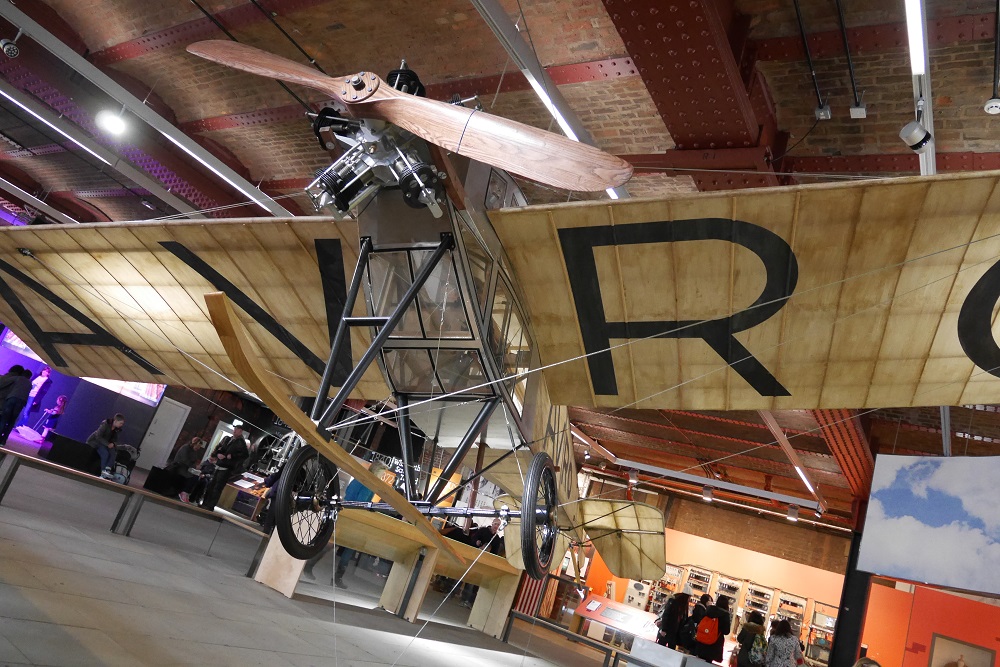
One of many airplanes in the three buildings occupied by the impressive Museum of Science and Industry.
Museum of Science and Industry (aka MOSI)
A sprawling museum with three huge buildings, it’ll take nearly 2 kilometres of walking just to see all this great facility offers (including a short ride on one the world’s first passenger train line, pulled by an 1830 steam engine!). You’ll find everything from textile industry machinery through to trains and planes in this museum.
It’s all about Manchester’s contribution to industry and science, and considering the first real industrial factories sprang up in this town, it’s a contribution that forever changed our way of life – for good and ill. Loaded with kid-friendly exhibits, this is a great place to bring your kinds and inspire them about the possibility of what mankind and a little science can create together. It’s free and worth at least 2-3 hours of your day.
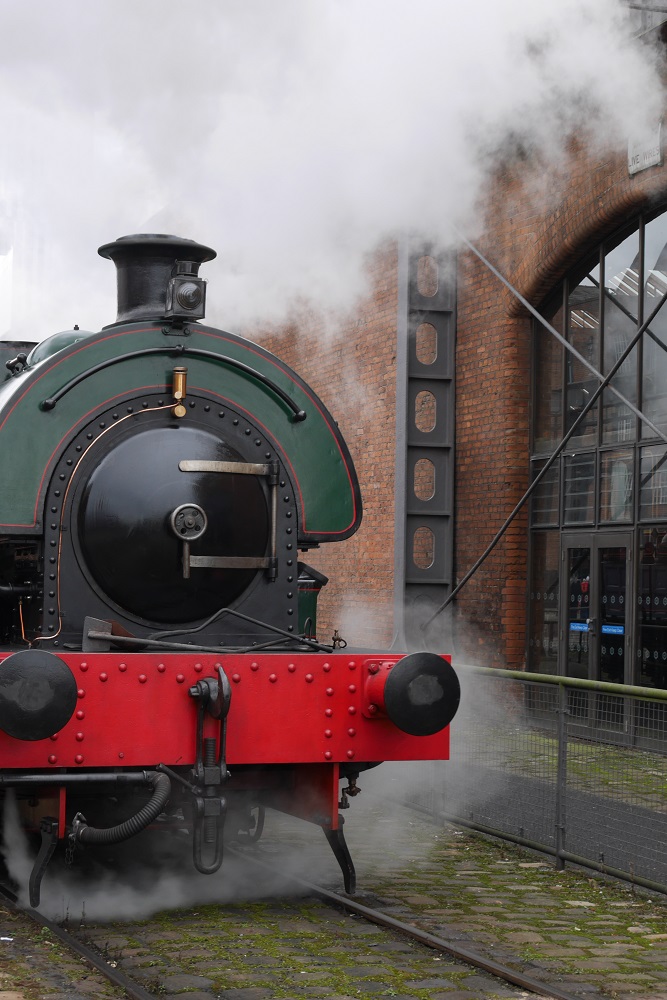
Dating to around 1830, this is the real deal with an authentic early “passenger car” that was in cattle-car style. This is the site of the first-ever passenger rail service and this engine was one of the early participants. You can ride it for a couple pounds daily between 12 and 4.
People’s History Museum
After I left this museum, I wanted to arrange an uprising and storm a bank. For whatever good the Industrial Revolution wrought, it also led to great societal ills. From poor housing to insufferable working conditions and suppression of rights, it only took a few decades for people to realize they’d had enough. Manchester was ground zero for that discontent.
This was the town that inspired Karl Marx & Friedrich Engels, the birthplace of socialism. This was where the workers stood up and proclaimed that, without them, the world simply couldn’t work. From the fight for the right to vote through to the birth of unions and beyond, this fascinating museum is packed. You’ll find propaganda, speeches, and great cartoons. It stands as a testimony to when we, the people, said we were mad as hell and not gonna take it anymore.
I wish everyone could walk through there. Once before the 1% outvoted the 99%. Then the 99% changed everything for a hundred or so years, until we stopped demanding more.
This is a museum that deserves your visit. Give it 2-3 hours of your time, plan to do a lot of reading, and be sure you support them with a well-earned donation. I was amazed that such an anti-establishment museum is still alive via public funds. I hope it thrives for years to come.
National Football Museum
This is a fantastic museum for anyone, let alone football fans. The history of “soccer” is well laid out here. From hooliganism to its humble beginnings, through to plane crashes and stand tragedies, this museum has it. This sport has become part of British culture in the deepest possible ways. The museum is chock-full with things to play and look at, but some cost money (like the foosball tables). You could easily spend 2-3 hours, or more, here too.
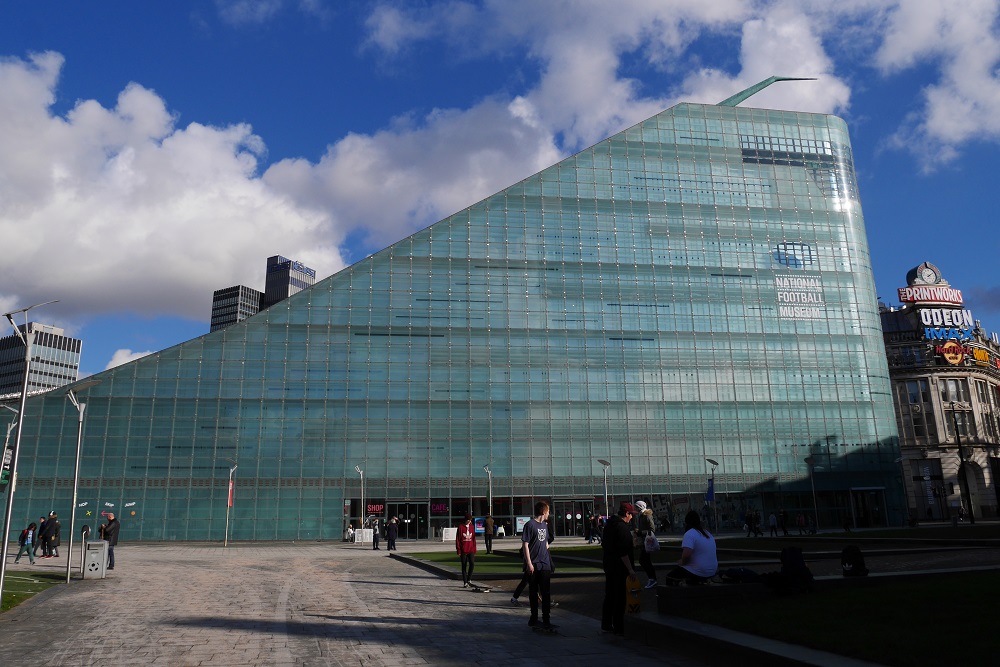
The impressive Football Museum will consume a good chunk of a morning or afternoon. Nearby is a nice cathedral and other distractions to fill your day.
Jodrell Bank Observatory
Space lovers can’t miss this. You’ll need a car to get here but it’s a lovely drive out into the countryside. The café is shockingly good for a “family activity” place, so you don’t need to worry about packing a lunch. I thought the brownies were sensational. There’s a small (somewhat dated) discovery centre that’s good for a bit of fun. The star of the show is the Lovell Telescope, one of the world’s three largest radio telescopes.
Its height is equivalent to 21 double-decker buses stacked. Some 168 double-decker buses could fit in its massive “dish.” It’s this behemoth that received the first-ever photos of the moon’s surface. It discovered breakthroughs about Pulsar stars. It’ll also be a huge player in the “square-kilometre array” of telescopes that hopes to come up with more breakthroughs in astronomy.
If you fancy a day in the countryside punctuated with a little learning, go see this telescope. It has such a place in our science history that it’s been name-dropped in Dr. Who and mentioned in Hitchhiker’s Guide to the Galaxy.
(And it’s worth noting they’ve received a £12-million grant to refurbish the grounds. There’s also a big music festival to come this summer, and other exciting new plans are in the works, so stay abreast of all things Jodrell and see what’s ahead for this big player in space science.)


